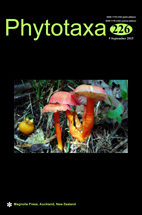Abstract
Pinus and Eucalyptus, being grown worldwide for timber and paper pulp industry, are depending on ectomycorrhizal fungi during their entire life cycle; especially Pinus is frequently found to be colonized by highly host-specific root mycobionts such as Suillus spp. or Rhizopogon spp. Although compatible fungi are usually not naturally present when the host tree genus is not native in the planted area, as in the case of Southern Chile, adventitious communities of ectomycorrhizal fungal partners with unknown origin are commonly observed along the extensive range of Chilean Pinus radiata plantations. We performed a molecular phylogenetic analysis focused on two taxa of Lactarius sect. Deliciosi and Rhizopogon, two very common but insufficiently studied ectomycorrhizal fungi in plantations of P. radiata in central Chile, in order to clarify both identity and origin of adventitious fungal strains. Based on ITS sequences from different specimens covering a larger distribution area, we identified the examined taxa as Lactarius quieticolor and Rhizopogon roseolus. This is the first record of L. quieticolor for South America and there is some evidence that the geographic origin of the examined strains of both species is in the Eurasian region rather than in North America where their host tree P. radiata is native, which raises the discussion how mycorrhizal partners of different geographical origins meet in an allochthonous area.

